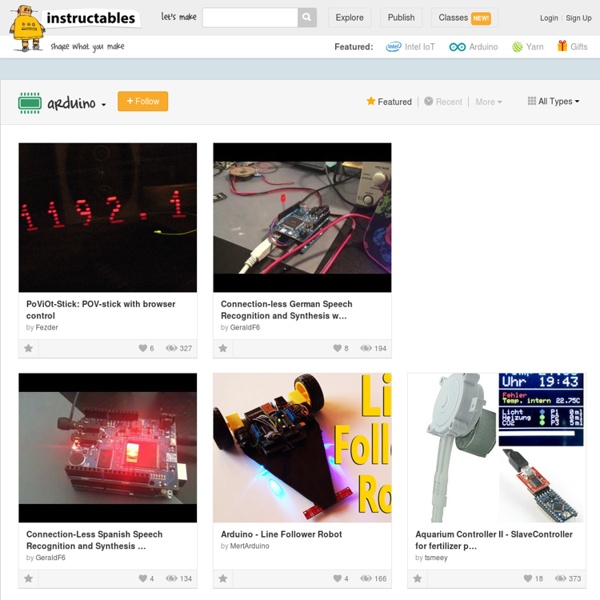



Arduino - Kit De Demarrage (traduction française du livre "Arduino Starter Kit") Plus d'images ... Here is the "Arduino Starter Kit !" : Site officiel (Kit en Anglais) Voici le "Kit de Démarrage Arduino !" : ici ou encore là (Kits en Français) Ce kit vous guide, grâce à des exemples pratiques, à travers les techniques de bases à connaître pour utiliser l'Arduino. Aujourd'hui, il est possible d'acheter un Kit de Démarrage Arduino entièrement traduit en Français. Ce sont ces traductions, ainsi que les textes originaux que je vous propose ci-dessous.Note : Les documents originaux en anglais sont parfois annotés en jaune lorsque j'ai détecté des coquilles dans le texte ou les illustrations Ces documents sont disponibles sous licence Creative Commons BY-NC-SA (Texte complet / Wikipedia), la licence sous laquelle a été publiée le texte du livre original fourni avec le "Starter Kit". J'ai également mis à disposition : - la bibliothèque des composants ( Les projets décrits dans le kit sont : 02 INTERFACE VAISSEAU SPATIAL - Créer le panneau de contrôle de votre navette
Technology Instructables 56 46 25 146 3259 15315 24453 91.3K 3126 4190 108 121.2K 311.3K 652.0K 25686 22703 21912K 26583 291.1K 918.7K 18664 4199 28862 261.2K 411.9K 151.0K 642.2K 501.2K 1073.1K 5314 19823K 11796 761.7K 12800 34689 16503 591.5K 9882 19584 7429 381.3K 31894 381.1K 312.0K 19588 7532 311.3K 26829 21727 271.0K 191.8K 14624 33876 601.1K 321.3K 884.1K 401.7K 20962
Khan Academy The Sandwich-o-Matic will make your lunch automatically The Sandwich-o-Matic will make your lunch automatically Arduino Team — December 6th, 2016 Love eating lunch, but hate making it? Good news, an automated machine may soon be able to take care of the task for you. The project–which was created during a thirty-six hour hackathon by the team of Clive Chan, Colin Daly, Alex Foley and Wilson Wu–is based on an Arduino and a Photon. The Sandwich-o-Matic accepts both voice and NFC requests. The Makers hope to even develop a future version, which will include more topping and condiment options as well as a more streamlined voice-to-sandwich process.
(+99) Curso de electrónica básica gratis A continuación te presento un excelente curso de electrónica básica en videos, creados por Alejandro Méndez. Altamente recomendables si tienes un precario conocimiento de electrónica. Resistencias: En estos videos se explica el comportamiento de uno de los componentes pasivos más utilizados en electrónica. link: link: Condensadores: En este video Alejandro habla sobre un importante componente pasivo: el capacitor. link: Bobinas: En este capítulo aprenderemos a distinguir el símbolo electrónico de este importante componente, su comportamiento en ac y dc, entre algunas otras cosas. link: Diodos: Aprenda los conceptos básicos del diodo. link: El transistor BJT: Aprenda los conceptos básicos de este importante componente activo controlado por corriente. link: link:
DIY – Un tutoriel pour créer un livre en réalité augmentée La réalité augmentée et la réalité virtuelle sont les grands sujets du moment, avec un casque, des lunettes connectées, un smartphone ou encore une tablette, on peut animer les pages d’un livre ou tout autre support papier. Convivial Studio propose à tout le monde de créer un livre en réalité augmentée avec du papier, des ciseaux, un Kinect et un projecteur et un peu d’habilité dans le coding. Ce petit tuto en mode Dot It Yourself (DYI) permettra de réaliser des prototypes avant d’investir des fortunes dans un projet finalisé. Pour réaliser ce prototype de livre animé, il faut comprendre les 14 étapes décrites dans le tutoriel. Pour accéder au tutoriel cliquez ici Découvrez d’autres articles sur la réalité augmentée Impresionante enjambre de pequeños robots cuadrópteros voladores By Publicado:febrero 1, 2012Publicado en: CienciaTags: cuadrópteros, inteligencia, robots Si alguna vez pensaron que el futuro estaba lejos y que nunca veríamos enjambres de robots pequeños que volaran en equipo mientras hacían formaciones extrañas, creo que tendrán que pensarlo dos veces. investigadores de la Universidad de Pennsylvania en el laboratorio GRASP, han estado haciendo experimentos con estos cuadrópteros desarrollados por KMel Robotics. Los vehículos haceen varias formaciones, trabajan en conjunto e incluso se posicionan con respecto a otros en un entorno 3D. No se pierdan el patrón en 8 al final del video. (Vía Reddit) Sobre el Autor Ingeniero en electrónica; editor en jefe de IdentidadGeek y un "tecnoadicto de mierda".
ComoHacer.eu | ¿Inventamos juntos?